In the vast pantheon of Greek deities, Nemesis stands as a symbol of divine justice and retribution. Her presence serves as a reminder that the universe seeks balance, and those who commit hubris or wrongdoing will inevitably face her wrath.
Nemesis Key Facts
Family tree
| Parents | Nyx (Night) alone or Nyx and Erebus |
| Partner(s) | Zeus |
| Siblings | Thanatos, Hypnos, and other Daemones |
| Offspring | Helen of Troy, the Telchines, Leda |
Names & Others
| Roman Name | Invidia |
| Other Names | Adrasteia, Rhamnousia |
| The Goddess of | Retribution and Divine Justice |
| Symbols | Wheel, whip, and sword |
Name and Etymology
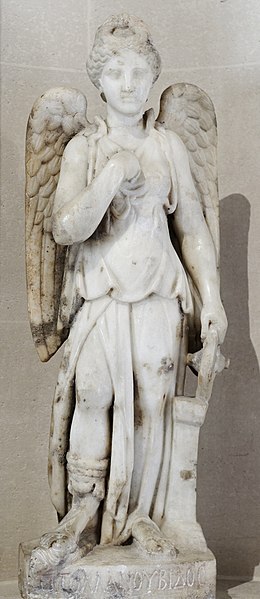
The name “Nemesis” is derived from the Greek word “nemēsis” which means “to give what is due.” It’s a fitting name for the goddess who ensures that individuals get what they deserve, be it good or bad. In Roman mythology, she’s known as Invidia, a name that evokes envy and jealousy, further emphasizing the concept of retribution.
Throughout the ages, Nemesis has been known by various epithets, each highlighting a different aspect of her nature. “Adrasteia,” meaning “the inescapable,” and “Rhamnousia,” named after her sanctuary in Rhamnous, are among the most prominent.
Her name, regardless of the epithet, has always been synonymous with balance and justice. It serves as a reminder that actions have consequences, and the universe always seeks equilibrium.
Origins
Nemesis, with her profound influence on the balance of the universe, has a lineage that befits her role. Born to the primordial goddess Nyx, and in some tales, to both Nyx and Erebus, she stands as a beacon of justice amidst a family of powerful deities. Her siblings, including formidable entities like Thanatos (Death) and Hypnos (Sleep), further emphasize the gravity of her lineage.
In the vast tapestry of Greek mythology, there exists a group known as the Daemones, which are personified spirits representing various aspects of life and human emotions. Nemesis, in this context, is the personified goddess of Indignation. Her very essence is to react against those who succumb to hubris and commit wrongdoings, ensuring that they face the consequences of their actions. This personification is a testament to the Ancient Greeks’ understanding of the universe’s need for balance and the role that emotions and virtues play in achieving it.
While many gods and goddesses had tales of playful childhoods filled with adventures, Nemesis was different. From her earliest days, she was acutely aware of her responsibilities. She grew up witnessing the actions of gods and mortals alike, preparing for the day she would intervene to restore balance. Her very existence served as a reminder that every action, whether divine or mortal, has consequences.
Nemesis Lovers and Relationships
Nemesis, in her quest to maintain balance, often kept herself detached from personal relationships. However, one significant relationship was with Zeus, the king of the gods. Their union was not one of love, but rather a complex interplay of power and destiny.
Zeus and Nemesis
Zeus, known for his many romantic pursuits, was drawn to Nemesis. However, she, understanding the implications of such a union, tried to evade him. In some tales, she transformed into various animals to escape his advances, but Zeus always matched her transformations. Their eventual union led to the birth of Helen of Troy, a mortal whose beauty would later ignite the Trojan War. This relationship underscores the intricate web of fate and destiny, where even the actions of gods can have far-reaching consequences.
Nemesis Offspring
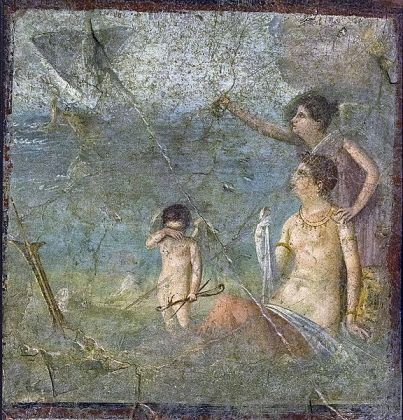
The lineage of Nemesis is as intriguing as her own tale, with each offspring playing pivotal roles in the vast narrative of Greek mythology. From her union with Zeus and perhaps other deities, Nemesis gave birth to several notable figures. Each of these offspring, whether divine or mortal, carries a part of her essence, further emphasizing the intricate web of fate and destiny.
Helen of Troy
Arguably the most renowned of Nemesis’ children, Helen’s beauty was unparalleled in both mortal and divine realms. Often referred to as “the face that launched a thousand ships,” Helen became the queen of Sparta. However, her abduction by Paris of Troy set the stage for the legendary Trojan War. Her life, a blend of blessings and curses, serves as a reflection of the duality inherent in Nemesis’ nature: beauty and chaos, love and war.
The Telchines
The Telchines, often described as ancient sea gods and skilled craftsmen, were another significant product of Nemesis’ lineage. Renowned for their metalwork, they were credited with crafting Poseidon, the god of the sea‘s mighty trident. However, their malevolent use of magic and their tendency to blur the lines between good and evil led to their eventual downfall. Their tale serves as a stark reminder of the balance between creation and destruction, a theme closely associated with their mother.
Leda
Another significant offspring of Nemesis is Leda. In some versions of the myth, Nemesis, trying to escape Zeus, transformed into a goose. Zeus, in turn, became a swan, leading to the birth of Leda, who later became the mother of the famous twins Castor and Pollux. This transformation and the subsequent birth of Leda highlight the recurring theme of fate and destiny, where even the gods cannot escape the consequences of their actions.
Depiction And Characteristics
Nemesis, as the embodiment of retribution, has a distinct presence in Greek art and literature.
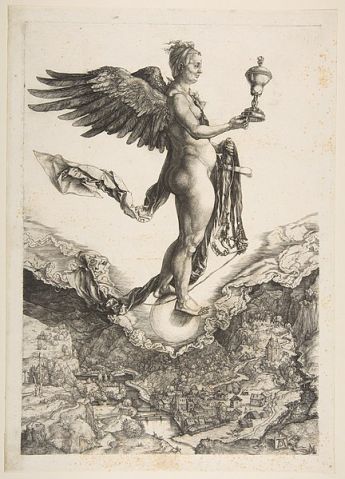
She is often depicted as a stern, regal woman, holding a whip, sword, or scales, symbols of her role in meting out justice. A wheel, representing the cycle of life and the inevitability of fate, is also commonly associated with her. Her attire, usually a flowing robe, adds to her majestic and imposing presence.
Personality and Powers
Nemesis is not capricious or whimsical. She embodies a sense of stern justice and is unwavering in her pursuit of balance. While she might seem harsh, her actions are not driven by malice but by the need to restore equilibrium. She is a reminder that the universe operates on a set of rules, and those who defy them will face consequences.
As the goddess of retribution, Nemesis possesses the unique ability to see every action and its repercussions. She can bestow fortune or misfortune, ensuring that individuals get their due. Her influence is not limited to mortals; even gods are subject to her judgment.
Nemesis Symbols
The wheel is a primary symbol associated with Nemesis, representing the cyclical nature of life and fate. The whip and sword, tools of punishment, emphasize her role in delivering justice. While not directly linked to specific animals or plants, her essence is often evoked by creatures like the owl, symbolizing wisdom and the ability to see things clearly.
Nemesis Roles And Responsibilities
Nemesis played a crucial role in the Greek pantheon. She was the universe’s response to imbalance. Whenever hubris, excessive pride, or wrongdoing went unchecked, Nemesis stepped in to restore order. Whether it was a mortal king who defied the gods or deities themselves indulging in excesses, she ensured that justice was served. Her responsibilities were not just reactive; her mere presence acted as a deterrent, reminding both gods and mortals of the consequences of their actions.
Myths about Nemesis
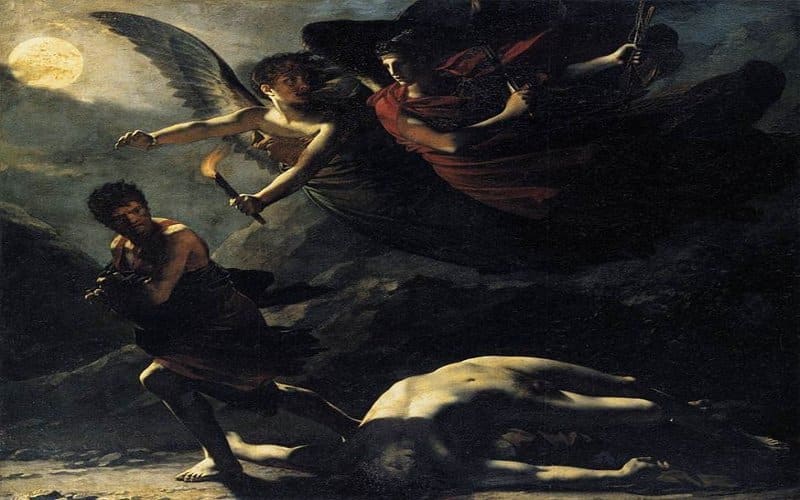
Nemesis, with her unwavering commitment to balance and justice, features prominently in several Greek myths. These tales not only highlight her role as the harbinger of retribution but also underscore the intricate interplay of fate, destiny, and the consequences of one’s actions. Let’s delve deeper into some of these myths, shedding light on Nemesis’ pivotal roles.
The Tale of Narcissus
Narcissus, a youth of unparalleled beauty, was not just blessed with good looks but was cursed with excessive pride. His vanity knew no bounds, and he took pleasure in spurning the affections of those smitten by him. Echo, a nymph, was one such individual who faced the brunt of his arrogance. Heartbroken by his disdain, she faded away until only her voice remained. Observing this tragedy and the pain Narcissus inflicted on others, Nemesis decided to intervene.
She led the haughty youth to a clear, still pool. There, Narcissus saw his reflection and, for the first time, was ensnared by a beauty he couldn’t possess. He fell deeply in love with his own image, unable to pull himself away. Days turned into nights, and still, he remained, gazing longingly at the reflection, which would never reciprocate his feelings. Eventually, this obsession consumed him, and he withered away, leaving behind a flower that bears his name. This tale, while tragic, serves as a stark reminder of the consequences of excessive pride and vanity and the inevitable retribution that follows.
Nemesis In Ancient Greek Religion
In the religious practices and beliefs of Ancient Greece, Nemesis held a position of reverence and, to some extent, fear. While she wasn’t worshipped with the same fervor as some of the Olympian gods, her role as the keeper of balance and justice was deeply acknowledged. Her influence was not just limited to myths; it permeated the very fabric of Greek religious consciousness.
Sites Sacred to Nemesis
The sanctuary of Nemesis at Rhamnous stands as a testament to her significance in the Greek religious landscape. Located north of Athens, Rhamnous was a remote and serene location, fitting for a deity whose essence was about introspection and reflection on one’s actions.
The temple at Rhamnous was unique. Unlike the grandeur associated with the temples of gods like Zeus or Athena, the goddess of wisdom, Nemesis’s sanctuary was more subdued, emphasizing solemnity over splendor. This temple housed a renowned statue of Nemesis, crafted by the illustrious sculptor Agoracritus. Interestingly, the statue was made from a block of Parian marble that the Persians brought to create a victory monument. After their defeat at Marathon, the Greeks used it for Nemesis’s statue, symbolizing retribution and the turning of fortunes.
Pilgrims from various parts of Greece visited this sanctuary, seeking Nemesis’s blessings or hoping to appease her. They would offer simple sacrifices, acknowledging her role in the cosmic balance. The very act of visiting such a remote sanctuary was, in itself, a form of penance and reflection.
The sanctuary also played a role in local festivals and rituals. While there weren’t grand celebrations in Nemesis’s honor, the rites performed at Rhamnous were deeply spiritual, emphasizing personal reflection and the acknowledgment of one’s deeds.
In the broader tapestry of Greek religious practices, Nemesis’s sanctuary at Rhamnous serves as a reminder of the delicate balance between hubris and humility, between actions and their consequences. It stood as a beacon, urging individuals to reflect on their deeds and understand the intricate dance of fate and retribution.
Representations Of Nemesis In Art
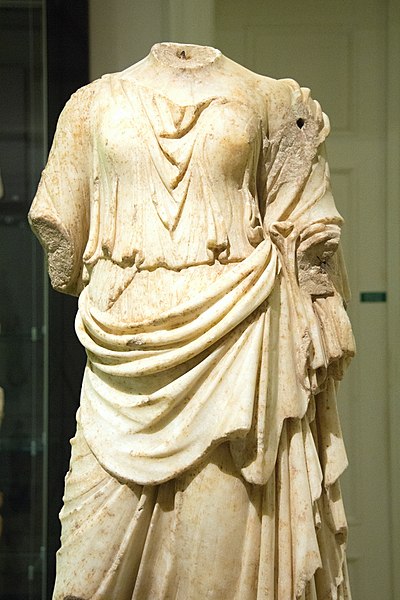
Nemesis, with her imposing presence, has been a favorite subject in Greek art. The statue at Rhamnous, crafted by the sculptor Agoracritus, is perhaps the most famous representation. Vases and murals have also depicted her, usually in scenes where she’s delivering justice or overseeing the balance of fate.
Mentions in Ancient Texts
Nemesis, with her profound influence on the balance of fate and justice, found her way into various ancient texts, each offering insights into her role and significance in the Greek cultural and religious landscape. These mentions not only highlight her importance but also provide a glimpse into the minds of the authors and the eras they lived in.
Hesiod’s “Theogony”
One of the earliest and most detailed accounts of Nemesis comes from Hesiod’s “Theogony,” written around the 8th century BCE. This foundational work, which charts the origins and genealogies of the gods, provides insights into Nemesis’s lineage and her role in the cosmic order. Hesiod describes her as the offspring of Nyx, the night, emphasizing her primordial nature. A notable quote from this text reads: “Nemesis, who brings pain to mortals, the hard-hearted, gives and takes away from both lowly and great.”
Stasinus’s “Cypria”
Another mention of Nemesis can be found in the epic poem “Cypria,” attributed to Stasinus, which dates back to the 7th century BCE. This work, which serves as a prelude to Homer’s “Iliad,” delves into the events leading up to the Trojan War. Nemesis’s role in the tale of the golden apple and the subsequent judgment by Paris is highlighted, emphasizing her indirect influence on the events that would lead to the great war.
Hyginus’s “Fabulae”
Fast forward to the 1st century BCE, and we find Nemesis being mentioned in the works of the Roman author Hyginus. In his collection “Fabulae,” a compilation of myths and legends, Hyginus recounts the tale of Nemesis and Narcissus. While the core of the story remains consistent with earlier versions, Hyginus’s rendition offers additional details, shedding light on the nuances of Nemesis’s character and her role as the agent of retribution.
These texts, spanning different eras and perspectives, underscore Nemesis’s enduring significance in Greek and Roman literature. They serve as windows into the past, allowing us to understand the multifaceted nature of this goddess and the values and beliefs of the societies that revered her.
Frequently Asked Questions
Nemesis is the goddess of retribution and divine justice, ensuring that individuals face the consequences of their actions.
The wheel, representing the cycle of life and fate, is a primary symbol associated with Nemesis.
Narcissus, due to his excessive pride and vanity, faced the consequences set by Nemesis.
Her most significant sanctuary was located at Rhamnous, north of Athens.
Indirectly, her principles of balance and retribution played out in the events leading to the Trojan War, especially concerning the dispute over the golden apple.
Hesiod’s “Theogony” provides detailed insights into Nemesis’s origins and her role in Greek mythology.
